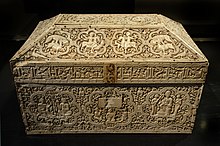Museo de Navarra
The Museo de Navarra ( Museum of Navarra ) is the central cultural museum of the Autonomous Community of Navarre ( Comunidad Foral de Navarra ).
Geographical location and museum building
The museum is located in Pamplona's old town on Cuesta de Santo Domingo Street . It uses some historic buildings there, which are supplemented by modern extensions. The museum is located on the site of the former Nuestra Señora de la Misericordia (Our Lady of Mercy) hospital from the 16th century, of which only the facade with the main entrance and the former chapel remain. The facade dates from 1556 and is the only example of civil Renaissance architecture preserved in Pamplona. The entrance is an interpretation of the classic triumphal arch , richly ornamented. The side entrance to the chapel has a facade in the form of an altar structure from the 17th century and comes from a church that was in the "Calle Mayor" in Puente la Reina . The chapel was built between 1547 and 1550 and is now the lecture hall of the museum.
History of the house
The museum is an institution that was founded in 1956 and is now state-owned by Navarre.
In 1932 the hospital housed there was relocated to the “Hospital de Navarra”, and from 1952 the building was converted into a museum, with almost nothing of the Renaissance building remaining. In 1986 another renovation took place, with which the museum was modernized and redesigned. According to the new museum concept, fewer objects were exhibited than before, which offers more space for viewing them. The aim was also to make the museum more attractive to the public: an auditorium, a hall for temporary exhibitions and facilities for other services were added. The collection was arranged chronologically, with prehistoric objects in a new exhibition room under the garden, Roman mosaics in the areas of the ground floor and - in ascending order - the rest of the exhibition on four floors. The objects were labeled exclusively in Spanish and Basque .
collection
history
The pieces come from the collections of the Commission for Historical and Artistic Monuments of Navarre (Comisión de Monumentos Históricos y Artísticos de Navarra), which was active since 1860. From 1940, their tasks were entrusted to the Institute of the Prince of Viana (Institución Príncipe de Viana), an institution under the government of Navarre, whose task is to protect, preserve and research the artistic and archaeological heritage of Navarre.
Outstanding objects

- Paleolithic bas-relief on a stone, so-called "Map of Abauntz"
- Roman mosaic from Andelos with a "Triumph of Bacchus "
- Roman mosaic of the villa of El Ramalete in Tudela
- Romanesque capitals of the previous building of Pamplona Cathedral
- "Caliph's box" from the monastery of San Salvador de Leyre , a masterpiece of ivory carving of Islamic art around 1000 AD.
- Gothic wall paintings
- Wall paintings in grisaille about the battles of Emperor Charles V against the Protestants
- Portrait of the Marquis of San Adrián, painted by Francisco de Goya
literature
- Alfredo Sarasa Asiain: Guía de arquitectura de Pamplona y su Comarca . Colegio oficial de arquitectos Vasco-Navarro, Pamplona 2006, ISBN 84-611-3284-X .
Web links
Coordinates: 42 ° 49 ′ 10 " N , 1 ° 38 ′ 46.2" W.


